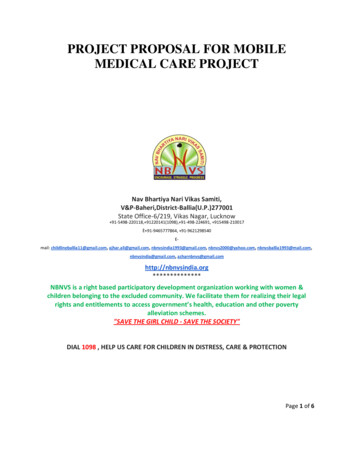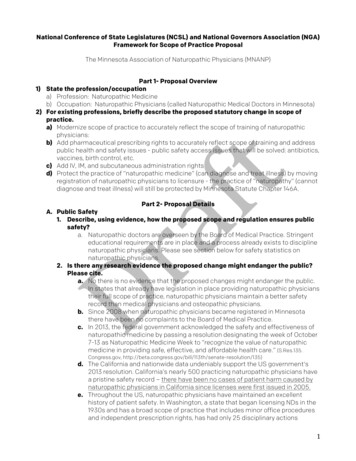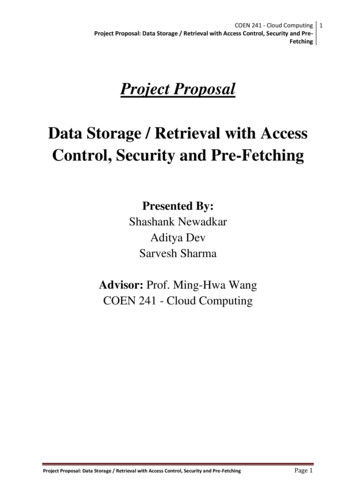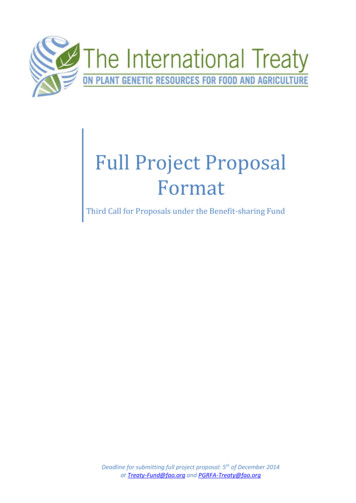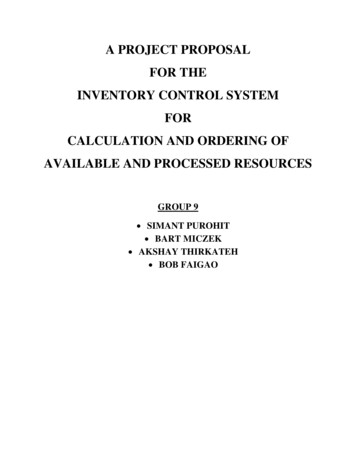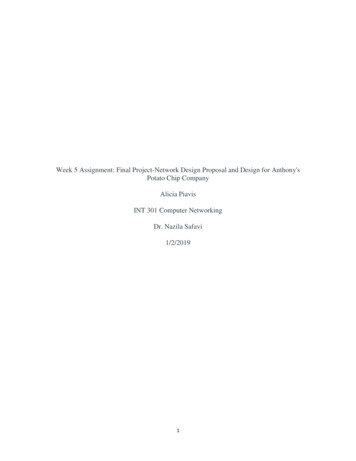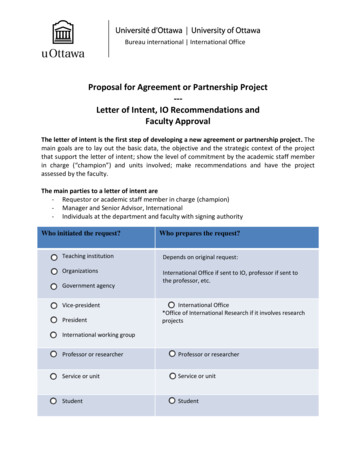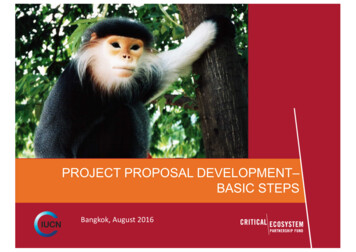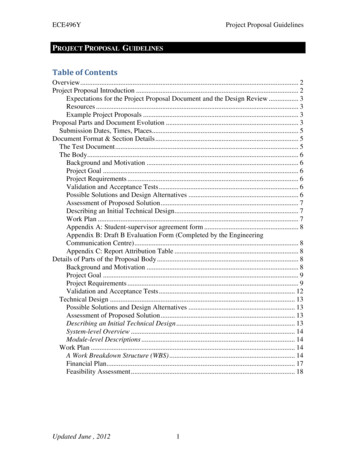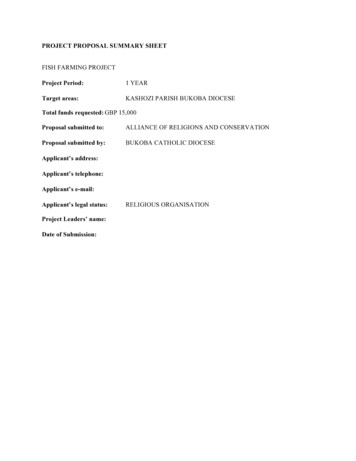
Transcription
PROJECT PROPOSAL SUMMARY SHEETFISH FARMING PROJECTProject Period:1 YEARTarget areas:KASHOZI PARISH BUKOBA DIOCESETotal funds requested: GBP 15,000Proposal submitted to:ALLIANCE OF RELIGIONS AND CONSERVATIONProposal submitted by:BUKOBA CATHOLIC DIOCESEApplicant’s address:Applicant’s telephone:Applicant’s e-mail:Applicant’s legal status:Project Leaders’ name:Date of Submission:RELIGIOUS ORGANISATION
EXECUTIVE SUMMARYFor the past few years the Catholic Diocese of Bukoba has been trying to find ways and means of mitigatingthe currently passive culture of her members in participating in community development programs especiallythrough initiatives originating from and developed by the church organizations such as the youth, women, menand other church groups.KASHOZI FISH FARMING PROJECT is a result of such initiatives. It has been developed through dialoguebetween the leadership of the church at Diocese level and the leadership of the parish and by involvingrepresentatives of the organizations of the church in the parish. Through this interactive process it was foundout that even though the parish is the oldest in the Diocese the evangelization process and member responsehas been declining due to a number of challenges among which are weak economies of the members andoutbreak of new religious denominations both of which contribute to poor participation of the catholicChristians in activities that promote evangelization at different levels.KASHOZI FISH FARMING PROJECT is only a component of the ongoing process for development of acomprehensive community development program (CONSERVATION AND FOOD SECURITY PROGRAM).This program is expected to promote other components as agro forestry, environmental management and otherareas according to nature and priority. This fish farming project has been appraised by considering manyopportunities available in the area of operation (Kashozi parish). The opportunities in the areas includeavailability of a vast marshy wetland of about 40 hectares, readiness and aggressiveness of the churchleadership in the parish, motivation and inspiration of the church groups and organizations and many otheropportunities.In the process of appraisal for this project other factors have been considered such as national policies andinitiatives for promotion fish farming and mobilization of the large communities for participation in theindustry. Also such factors as market of the products and farming systems have been studied and included inthis project proposal.
DESCRIPTION OF BUKOBA CATHOLIC DIOCESE2.1 Location:Bukoba Catholic Diocese lies 1º degree South of the Equator on the North Western corner of Tanzania. Itborders with Lake Victoria in the East, Rulenge – Ngara Catholic Diocese in the South, Kayanga CatholicDiocese in the West and the Republic of Uganda in the North.2.2 The Background of Evangelisation and Subdivision.From 1892 – 1912 Bukoba Catholic Diocese was a part of South Nyanza Vicariate, which comprised thepresent Rwanda, and the catholic Dioceses of Rulenge – Ngara, Kayanga, Mwanza, Musoma, Geita and someparts of Shinyanga and Kahama.It was evangelized by the White Fathers Missionaries.In 1912 a new Vicariate of Kivu, Rwanda, was formed, splitting it from South Nyanza Vicariate.
In 1929 the South Nyanza Vicariate was divided into two, namely Mwanza and Bukoba Vicariates.In 1951 Bukoba Vicariate was again divided into two Vicariates, namely, Lower Kagera Vicariate (comprisingthe Parishes of Rutabo, Kishogo, Mugana, Kanyigo and Kashambya) under Bishop Laurean Rugambwa of theDiocesan clergy, and Bukoba Vicariate (comprising the Parishes of Kashozi, Kagondo, Rubya, Ngote,Bugene,Buhororo, Katoke, Nyamigere, Rukora and Rulenge), under Bishop Alfred Lanctot, a White Father. In1953 both Vicariates were raised to the diocese status. Lower Kagera took the name Rutabo Diocese andBukoba Vicariate took the name Bukoba Diocese.In 1960 when bishop Laurean Rugambwa was created Cardinal, Rutabo Diocese was reunited with part ofBukoba Diocese to comprise the actual political districts of Bukoba Urban, Bukoba Rural, Muleba andMisenye. At the same time remaining part of the former Bukoba Diocese, comprising the present Diocese ofRulenge – Ngara and Kayanga, became the new Diocese of Rulenge under Bishop Alfred Lanctot as its firstBishop.2.3 Population:According to the latest census of 2003, Bukoba Catholic Diocese has the total population of about 862,679people: (424,438 males, 438,241 females). Out of these 59% are Catholics, 24% Protestants, and 12%Moslems and 5% Traditionalists.2.4 Parishes:Bukoba Catholic Diocese has thirty (32) parishes in all. They are run by Diocesan priests and three (3)missionaries of the congregation of the Apostles of Jesus.We have two Diocesan Congregations of Women Religious, namely, Sisters of St. Therese of the Child Jesusand the Daughters of Our Lady of Perpetual Help. There are also missionary congregations of sisters andbrothers from outside the country. They render valuable services in our Institutions.Bukoba diocese has two major unions of the affiliated groups namely, the Catholic Women’s Union and theCatholic Youth’s union. These groups are available and active almost in all parishes. These groups help in thesensitization and maintenance of good values in all communities2.5 List of assets owned and run by the dioceseBukoba Catholic Diocese owns a list of assets ranging from big hospitals to health centres and Dispensaries.Bukoba Catholic Diocese also owns Schools ranging from nursery and preparatory schools to advanced levelsecondary schools. Down here is a list of some of these assets1.a.b.c.d.e.f.g.Schools & collegesNursery (7schools)Primary (1 school)Secondary( 3 schools)High schools (3 schools)Junior seminary (2 seminaries)Major seminaries (1 seminary)Teachers colleges (1 college)
h.i.j.2.a.b.c.d.3.a.4.a.b.Vocational training colleges (4 colleges)Catechists college (1 college)University (1 college)Hospitals & health facilitiesDistrict hospitals (1 hospital)Referral hospital (1 hospital)Health centres ( 3 health centres)Dispensaries (2 dispensaries)Press &Printing housesPrinting house (1 printing house and press)Hotels and restaurantsHotels (1 hotel, biggest in the area)Restaurants (3 restaurants)2.6 Land ownership in the dioceseBukoba Catholic Diocese owns land. Most of the land owned by Bukoba Catholic Diocese is located inparishes. Big part of this land has not been surveyed except for a small part and therefore the diocese does nothave title deed for the unsurveyed land. An estimate is made though that this land would amount to 3000hectares. Most of the land is occupied by forests with both indigenous and exotic species of trees. In someareas also the land is occupied by food crops such as bananas, and also some occupied by cash crops such ascoffee.However efforts are underway for survey of all the land belonging to the diocese and exercise which is goingon.2.7 Environment and agriculture development work already done by dioceseBukoba diocese has always participated in environment protection work by planting trees on about 2500hectares of land owned by diocese in different parishes. These trees were planted by involving affiliated groupsand also during major ceremonies like confirmation in some of the parishes. Since some of these forests areestablished at educational institutions students and collegians have been involved in planting and maintenanceof these forestsThe diocese has also been practically in agriculture development by establishing farming plots in all educationinstitutions owned and run by the diocese. These plots provide food for use at the institutions but also theyhave sometimes been used by government extension staff for demonstration of proper use of sustainable landuse management for other farmers in the neighbourhood. These plots have also been a major source of food forpriests and sisters in all parishes and houses
KASHOZI PARISHKashozi parish was founded in the year 1892. It is the oldest parish in the Diocese. It covers a total surface areaof 102.34 square meters. It covers 2 wards and 15 villages of the government administrative boundaries.Kashozi parish is subdivided in 6 Sub Parishes and it has a total of 75 Small Christian Communities. The areacovered by Kashozi parish has a total population of 18,446 and 12, 077 people which are approximately 65.5%are Catholic Christians.Kashozi parish has three Christian organisations namely Women organisation, Men organisation and Youthorganisations. The women organisation of the parish has a total membership of 150 while the men organisationhas a total of 24 while the youth organisation has a total membership of 80. Kashozi parish also has a choircomposed of both youth and adult male and female members and it has a total membership of 44 currently.These church organisations have a major role of participating in general activities at the parish premises whenthere are main events like ceremonies at the parish and convents or at homes of Christians when there are suchevents. This membership and involvement of the organisations is one of the challenges that has led to theappraisal of this project because it is expected that once this project becomes operational the membership willincrease and the organisations will have more binding activities.Kashozi Parish has a number of facilities owned and run by the Diocese but serving a large non segregatecommunity. These facilities include Nkindo Teachers College, Kashozi Home Craft, Hekima Secondary andHigh School, Kashozi Health Center, Kashozi Vocational Training Center and a small carpentry industry.The Overall objective of our program is;To contribute to “improved livelihood and Life expectancy for people in the project area of operationthrough sustainable conservation of natural creation.The program will contribute to the achievement of the above development objective through two immediateobjectives; Focused Reading and reflection of the world of God for Conservation of natural Creation. Assurance for food security, medicine, nutritional status & income for social security at household level.The following six outputs have been developed to enable the program reach its objectives: Increased practice of Bible reading and reflection through Small Christian Communities Increased focus on faith communities to restore and conserve natural creation Increased & diversified food supply thro’ application of agro forestry technologies. Improved nutritional status. Improved farmers’ utilization of agro forestry products. Increased access to financial services for social security and insurance
The vision of Lake Victoria Conservation and Food Security Program is “A world free from poverty andinjustice”.The Lake Victoria Conservation and Food Security Program has a three-pronged development objectivenamely: To contribute to the improvement of living conditions of people belonging to organisations supported by LakeVictoria Conservation and Food Security Program To promote faith values as the means to restoring and sustaining hope for humankind. To contribute to the development of a peaceful and just society. To contribute to sustainable development in the program area of ber–basedcatholicfaithorganizations.3. The Purpose of the projectThe purpose of this project is to respond to the major religious, economic, social and cultural challenges facingthe community in the project area of operation.3Project DescriptionThe project will be conducted by covering the following core activities.i.Land analysis and environmental impact assessment.This activity will be conducted in collaboration with professional consultants. The importance of this processis to provide input for sustainable utilization of the wetland which is a natural creation which needs to beconserved for both sustainability of the project and continued support of nature and lives in the ecosystemaround the area. Since the area involves a catchment of a permanent water runoff stream it will be important
for this activity to come up with better suggestions for use of the water from this stream but also conservationof this stream. This process will also suggest better ways for frequent testing of the water so that a risk ofpoisoning for both fish and humans could be avoided.ii.Sensitization and mobilization for group formation and consolidationThis core activity might be conducted simultaneously with core activity i. above. In this activity the projectimplementers will be organized and visited by a team of project advisers either in separation or by bringingrepresentatives of different groups together depending on the set up and convenience. During this activity thegroups will be advised on strengthening member participation by organizing meetings and confirmingparticipation especially of those members who are not active currently. The groups will also be taken throughthe major steps for fish farming from step one to the last step. At the end of this activity members will come upwith action plan outlining responsibilities and for their members and timelines for accomplishment of the otherfollowing steps. During this activity the groups will form committees for various responsibilities and some ofthe already proposed committees are the project monitoring and evaluation committee and the marketingcommittee. This activity also should take a maximum of one month.iii.Project development and implementationThis is the major activity where all small activities will be undertaken. This activity begins from digging theponds across all other steps to fish harvesting. During the period in which this activity will be conducted theproject implementers might be undergoing other trainings and given skills in other participatory processes suchas saving and loan and enterprise development.iv.Monitoring and evaluationThis is a core activity which will be conducted by the project implementers in collaboration with the projectadvisors. In this activity the parties will develop mechanisms and tools for ensuring that all the activities go asplanned by taking into consideration all the important components. 5. The project beneficiariesThe successful implementation of this project will benefit a number of linked groups which are:The catholic Christians who will increase their food, nutrition and income at household levelThe catholic small communities which will work closely to improve their social welfareThe church organizations which will improve their livelihood and participation in church work/religiousactivitiesThe catholic church in the parish whose livelihood and evangelization work will be improvedThe local government in the project area of operation which will capitalize on the efforts and initiatives in thisproject to copy or extend the knowledge and skills to other indirect beneficiaries and therefore rise economy ofall the communityFish farming/Aquaculture sector in TanzaniaAquaculture in the United Republic of Tanzania has a vast but as yet untapped potential. The industry isdominated by freshwater fish farming in which small-scale farmers practice both extensive and semi-intensivefish farming. Small fish ponds of an average size of 10 m x 15 m (150 m2) are integrated with otheragricultural activities such as gardening and animal and bird production on small pieces of land. The UnitedRepublic of Tanzania is currently estimated to have a total of 14 100 freshwater fishponds scattered across themainland. In addition, there is a large rainbow trout (Oncorhynchus mykiss) farm with an area of 25 m x 25 m
situated in Arusha.The distribution of fishponds in the country is determined by several factors such as availability of water,suitable land for fish farming, awareness and motivation within the community on the economic potential infish farming.Although very profitable internationally, shrimp farming is still in the experimental phase in The UnitedRepublic of Tanzania, a number of private companies have acquired plots and permits for the culture ofshrimp. Shrimp farming has the potential to be a profitable activity in The United Republic of Tanzania butthere are widespread concerns about its potential environmental and socio-economic impacts based onobservation of the global industry.In recent years seaweed farming has become popular in some coastal areas as a means of income generation.Small-scale seaweed farms on suitably selected sites, some of which are run by groups of women and youth,are scattered along the entire coastline of the country, from Tanga in the north to Mtwara in the south, and inthe islands of Mafia and Zanzibar. Seaweed cultivation has rapidly emerged as one of the major cash crops inTanga and Zanzibar, producing enough income to cover household costs. The species farmed are Kappaphycuscottonii and Eucheuma spinosum. Kappaphycus cottonii is believed to be indigenous while Eucheumaspinosum and E. striatum were originally imported from the Philippines. There is also potential for the farmingof other seaweed species such as Glacilaria.1. History general overviewThe history of fish culture in The United Republic of Tanzania is not well documented. According to Balarin(1985) it started in 1949 with experimental work on the culture of tilapia at Korogwe (in Tanga Region) andMalya (in Mwanza Region) during which many ponds were constructed. These ponds ended up being largelynon-productive due to lack of proper management and use of incorrect technology coupled with physicalproblems such as drought and poor infrastructure. According to reports from FAO, 8 000 fishponds had beenconstructed in The United Republic of Tanzania by 1968. However, some of the ponds were too small in size(at times as small as 20 m2) and with very low production, probably resulting from poor management.Water reservoirs constructed for use in homes or for livestock, irrigation and factories or for flood-control werestocked with tilapia. This practice started in 1950 and by 1966, 50 percent of the reservoirs in the country hadbeen stocked by the Fisheries Division. In 1967, the government launched a national campaign on fish farmingwhich was unsuccessful, again due to improper management. In 1972, aquaculture was, for the first time, givensome importance in the fisheries policy. After that, aquaculture was included in the Fisheries Policy althoughalways as a low priority sector. Several small aid projects have been directed towards the development ofaquaculture in the country but have not had the expected success. Interest in mariculture began with earlyinvestigations of seaweed farming including work by Mshigeni who introduced the concept from thePhilippines. The first seaweed farms in Zanzibar were started in 1989.The United Republic of Tanzania has a good potential for development of mariculture. In 1996 a survey wasconducted along the entire coastline for selection of a preliminary shrimp culture site, with support from theUnited Nations Economic Commission for Africa (UNECA). The findings indicated that the country has a bigpotential for shrimp culture which can be developed from the northernmost region of Tanga to the
southernmost area of Mtwara. The total area identified as suitable for shrimp farming was 3000 ha from whichpotential production was estimated a
Teachers colleges (1 college) h. Vocational training colleges (4 colleges) i. Catechists college (1 college) j. University (1 college) 2. Hospitals & health facilities a. District hospitals (1 hospital) . Increased practice of Bible r
